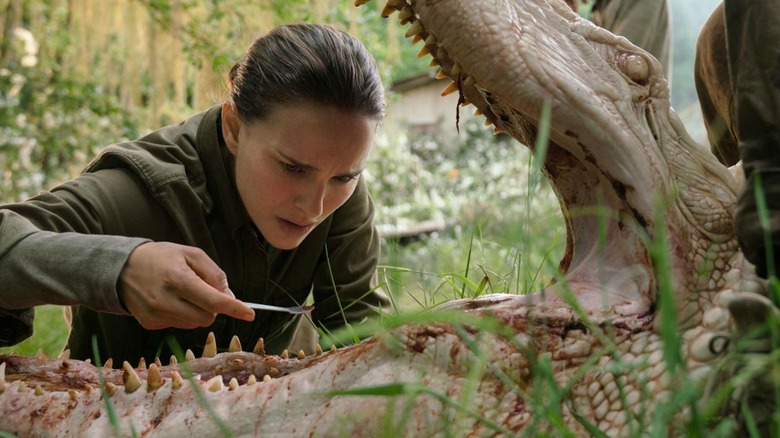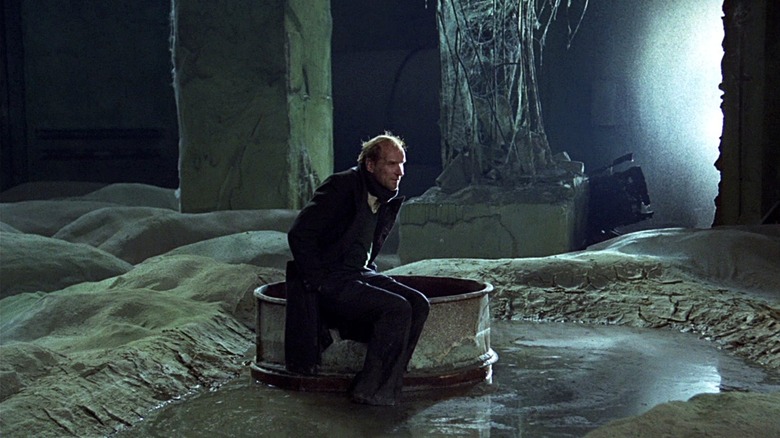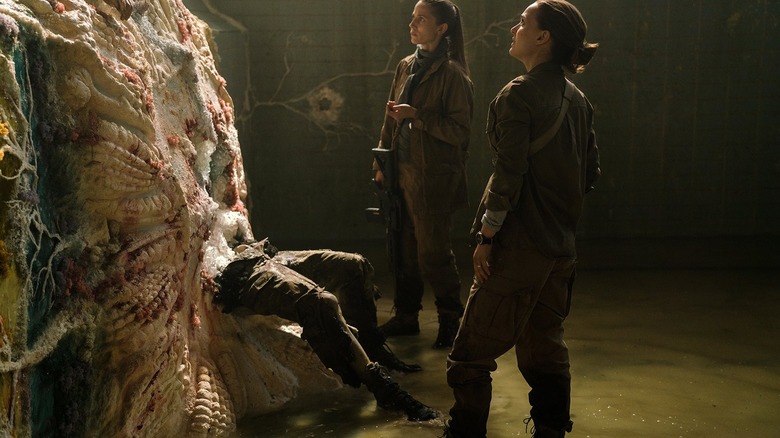The Soviet Sci-Fi Classic That Inspired Annihilation
Based on the first book in Jeff VanderMeer's Southern Reach trilogy, Alex Garland's 2018 film "Annihilation" is a contemplative and trippy sci-fi fable about a team of scientists who infiltrate an area — nicknamed The Shimmer — that has been infected by an ineffable alien influence which causes living beings to mutate, merge, and casually swap DNA with each other. Over the course of the film, the lead scientist Lena, played by Natalie Portman, comes to understand that animals and plants are getting a little too chummy, and has to survive an increasingly terrifying animal/human hybrids; if the screaming bear doesn't give you nightmares, your constitution is stronger than mine. Eventually, Lena finds the center of The Shimmer, and the source of the mutations. There, she faces off with faceless version of herself.
"Annihilation" takes its themes, to this critic's eye, from psychoanalyst Sabina Spielrein's. Spielrein, a colleague of Sigmund Freud and who had a relationship with Carl Jung, proposed the notion that self-annihilation is an inescapable part of the human psyche, and that we simply possess the instinct toward self-destructive behavior. Sigmund Freud would expand Spielrein's theory into his own notions into what he re-dubbed the death drive. The themes of self-annihilation in "Annihilation" are most evident in the above-mentioned doppelgänger scene; Lena has to literally destroy a version of herself.
Garland may have been inspired by Freud and Spielrein, but he was more explicit about his cinematic influences in interviews. "Annihilation" takes a lot of its visual clues, its languid pacing, and its general setup from the 1979 Soviet sci-fi film "Stalker" from Andrei Tarkovsky.
Andrei Tarkovsky's Stalker
Andrei Tarkovsky is well-known to students of cinema, and his name is frequently found in the mouths of other master filmmakers. Resembling literature, Tarkovsky's films take place in metaphysical spaces where memory and reality seemingly overlap. Among Tarkovsky's more celebrated films are "Ivan's Childhood," "Andrei Rublev," the 1972 sci-fi film "Solaris," and, most pertinent to Alex Garland, "Stalker."
"Stalker" is perhaps most notorious for its pace. Tarkovsky's trademark is long, sustained shots that can last for minutes at a time. "Stalker" run 161 minutes and had 142 shots, a miniscule amount when compared to the modern average (a 2017 film study found that the average number of shots in a feature film over the course of the previous two decades was 1,045). It tells the story of the title character (Alexander Kaidanovsky) who leads a writer (Anatoly Solonitsyn) and a professor (Nikolai Grinko) into a dangerous, unpopulated nature preserve called The Zone in order to find a magical room that grants wishes. It's dangerous to traverse The Zone, and much of "Stalker's" runtime is devoted to the character throwing a small, weighted bag ahead of them to check for "traps."
The mystery and the plot of "Stalker" fall into a vortex of the film's own downbeat melancholy. There is more in the way of conversation, explanation as to why each of these men want the wishes they do, and the dreams they have had. There is a Morphean quality to "Stalker," deliberately enticing the audience into a hazy, somnambulist stupor. Tarkovsky seems to be creating a half-subconscious space where dreams become the predominant logic. "Stalker" was not widely beloved upon its release, and the studio that released it — an adjunct of the Soviet government — criticized it for being too slow (Indeed, the first notable similarity between "Annihilation" and "Stalker" is that their respective producers hated them. In an article on Bright Lights Film, producer David Ellison was quoted, decrying the film, for being "too intellectual").
In the ensuing decades, "Stalker" has made its way onto lists of the best film ever made, even appearing on the Sight and Sound poll in 2012.
The Zone and The Shimmer
The parallels are easy to see. Both "Annihilation" and "Stalker" are about a group of outsiders exploring a mysterious, unpopulated natural enclave that is under the influence of a dark, ineffable alien force of some kind. Both The Zone and The Shimmer are fraught with peril, the former having traps, the latter having plant/animals that will absorb and mutate you. In each, the characters exploring their respective enclaves seem to go through a mental break or have an existential crisis. Both films, rather importantly, use their ethereal otherworlds as a clear metaphor for human depression, and characters in both movies internalize their respective missions as a symbol for their sadness. And, finally, both conclude — not to spoil the ending of either film — with a strange manifestation of supernatural power.
Garland has admitted openly to being influenced by "Stalker," and "Annihilation" cinematographer, Rob Hardy (who also shot Garland's films "Ex Machina" and "Men") once posted a still from "Stalker" to his Instagram account, declaring it "the only film to appear in the research library for our current film."
Alexander Knyazhinsky served as cinematographer on "Stalker," and he famously desaturated the scenes that took place in The Zone, presenting a world that was largely sepia and muted. While "Annihilation" operates with a wider color palate than "Stalker," there is a bizarre, indescribable natural-world quality to the light and the saturation that make The Shimmer seem ever-so-slightly unreal. It's difficult to define how, but the two films have a similar feel. The most striking thematic difference between Tarkovsky's film and Garland's is that the former is explicitly about freeing one's self from the confines of Soviet oppression, and the other is (arguably) about losing one's self to tempting nihilism.
A double feature would likely prove rewarding.


